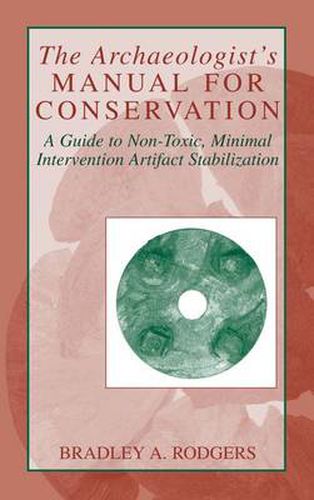Readings Newsletter
Become a Readings Member to make your shopping experience even easier.
Sign in or sign up for free!
You’re not far away from qualifying for FREE standard shipping within Australia
You’ve qualified for FREE standard shipping within Australia
The cart is loading…






This title is printed to order. This book may have been self-published. If so, we cannot guarantee the quality of the content. In the main most books will have gone through the editing process however some may not. We therefore suggest that you be aware of this before ordering this book. If in doubt check either the author or publisher’s details as we are unable to accept any returns unless they are faulty. Please contact us if you have any questions.
‘This manual is designed to take the mysticism out of archaeological artifact conservation and act as both reference and guide. It is intended as a tool to assist archaeologists in stabilizing a majority of the artifacts they excavate, or those already in storage. These stabilized archaeological collections will be preserved into the future, permitting reexamination and multiple interpretations of the data as our knowledge base grows through time. In addition, conservation will permit improved in-depth primary artifact interpretation, as fully conserved artifacts reveal fabrication, wear patterns, and detail impossible to detect in non-conserved artifacts. Conservation, therefore, is a critical tool within archaeology, a tool that becomes less meaningful if it is isolated, or seen as merely a technical skill that can be farmed out to the hard sciences. The Archaeologist’s Manual for Conservation is intended as a counterpoint to the popular specialization trend. My goal in offering this manual is to put artifacts back in the hands of archaeologists or material culture specialists who can best decipher them, opening avenues of artifact or material culture interpretation that are disappearing as artifacts either decay in storage or are sent away to the conservation professionals .’ - from the Introduction This book is the culmination of over 10 years of work and the merging, expansion, and improvement of 2 previous works: Conservator’s Cookbook and Conservation of Water Soaked Materials Bibliography. Each chapter covers a particular substance: Chapters begin with a visual flow chart, walking the archaeologist through a step-by-step stabilization process, backed in the text by theoretical discussion and description. Practical methodology follows theory in each chapter giving the archaeologist a more detailed description of preserving material remains. Chapters are backed and serviced by the most comprehensive bibliographic reference available today. The Archaeologist’s Manual for Conservation was developed through extensive documentary research, laboratory trial and error, and the feedback of both underwater and terrestrial archaeologists. It will become an indispensable reference for all archaeologists, laboratory technicians, archaeology students, curators, and conservators concerned with simple, proven, non-toxic, artifact conservation procedures.
$9.00 standard shipping within Australia
FREE standard shipping within Australia for orders over $100.00
Express & International shipping calculated at checkout
This title is printed to order. This book may have been self-published. If so, we cannot guarantee the quality of the content. In the main most books will have gone through the editing process however some may not. We therefore suggest that you be aware of this before ordering this book. If in doubt check either the author or publisher’s details as we are unable to accept any returns unless they are faulty. Please contact us if you have any questions.
‘This manual is designed to take the mysticism out of archaeological artifact conservation and act as both reference and guide. It is intended as a tool to assist archaeologists in stabilizing a majority of the artifacts they excavate, or those already in storage. These stabilized archaeological collections will be preserved into the future, permitting reexamination and multiple interpretations of the data as our knowledge base grows through time. In addition, conservation will permit improved in-depth primary artifact interpretation, as fully conserved artifacts reveal fabrication, wear patterns, and detail impossible to detect in non-conserved artifacts. Conservation, therefore, is a critical tool within archaeology, a tool that becomes less meaningful if it is isolated, or seen as merely a technical skill that can be farmed out to the hard sciences. The Archaeologist’s Manual for Conservation is intended as a counterpoint to the popular specialization trend. My goal in offering this manual is to put artifacts back in the hands of archaeologists or material culture specialists who can best decipher them, opening avenues of artifact or material culture interpretation that are disappearing as artifacts either decay in storage or are sent away to the conservation professionals .’ - from the Introduction This book is the culmination of over 10 years of work and the merging, expansion, and improvement of 2 previous works: Conservator’s Cookbook and Conservation of Water Soaked Materials Bibliography. Each chapter covers a particular substance: Chapters begin with a visual flow chart, walking the archaeologist through a step-by-step stabilization process, backed in the text by theoretical discussion and description. Practical methodology follows theory in each chapter giving the archaeologist a more detailed description of preserving material remains. Chapters are backed and serviced by the most comprehensive bibliographic reference available today. The Archaeologist’s Manual for Conservation was developed through extensive documentary research, laboratory trial and error, and the feedback of both underwater and terrestrial archaeologists. It will become an indispensable reference for all archaeologists, laboratory technicians, archaeology students, curators, and conservators concerned with simple, proven, non-toxic, artifact conservation procedures.